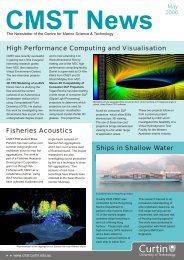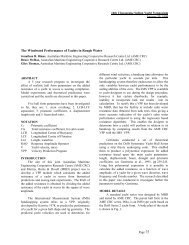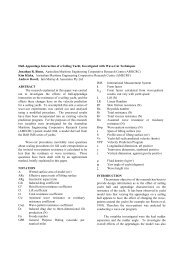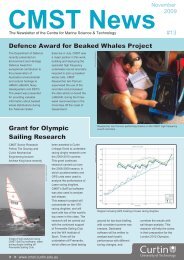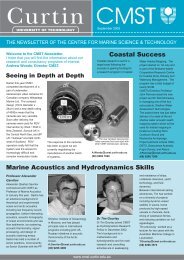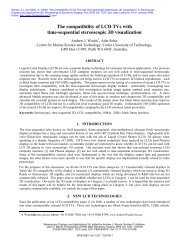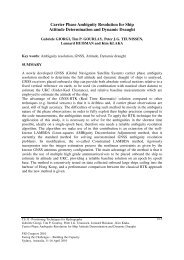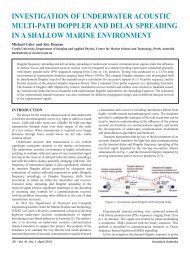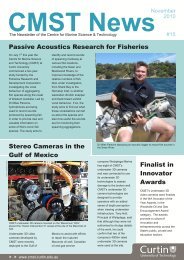Blue whale calling in the Rottnest trench-2000, Western ... - ANP
Blue whale calling in the Rottnest trench-2000, Western ... - ANP
Blue whale calling in the Rottnest trench-2000, Western ... - ANP
Create successful ePaper yourself
Turn your PDF publications into a flip-book with our unique Google optimized e-Paper software.
Abstract<br />
Through January-April <strong>2000</strong> research was carried out off <strong>the</strong> <strong>Rottnest</strong> <strong>trench</strong> to search for blue or<br />
pygmy blue <strong>whale</strong>s. A consortium of researchers carried out aerial surveys, boat surveys and<br />
acoustical measures. Historical records led us to believe that a <strong>Western</strong> Australian population of<br />
pygmy blue <strong>whale</strong>s (Balaenopteridae musculus brevicauda, sub species of <strong>the</strong> true blue <strong>whale</strong>,<br />
B. m. musculus) existed, while a prelim<strong>in</strong>ary boat survey <strong>in</strong> 1994 suggested that some of <strong>the</strong>se<br />
animals aggregated <strong>in</strong> <strong>the</strong> <strong>Rottnest</strong> <strong>trench</strong> west of Perth. This was confirmed <strong>in</strong> <strong>the</strong> <strong>2000</strong><br />
observations, aerial surveys sighted up to eight blue <strong>whale</strong>s/flight with<strong>in</strong> <strong>the</strong> <strong>trench</strong> and <strong>in</strong> 30<br />
days boat search<strong>in</strong>g 17 blue <strong>whale</strong>s were sighted. Five thousand acoustic records were made,<br />
many of which had blue <strong>whale</strong> <strong>call<strong>in</strong>g</strong> <strong>in</strong>, some hav<strong>in</strong>g up to n<strong>in</strong>e animals <strong>call<strong>in</strong>g</strong> at once.<br />
Although of a slightly different format, <strong>the</strong> calls recorded were of a similar character to those<br />
described from o<strong>the</strong>r blue <strong>whale</strong> populations. A call comprised three components, <strong>the</strong> first (type<br />
I) dom<strong>in</strong>ated by a 19 Hz tone for 21 s followed by a jump to a 21 Hz tone for a fur<strong>the</strong>r 22 s. Five<br />
to ten s later <strong>the</strong> second component (II) followed which was dom<strong>in</strong>ated by a long frequency<br />
upsweep, beg<strong>in</strong>n<strong>in</strong>g near 20 Hz and <strong>in</strong>creas<strong>in</strong>g to 26 Hz over 23 s. Approximately 23 s later <strong>the</strong><br />
third component followed, this dom<strong>in</strong>ated by a 20 s, 19 Hz tone. Harmonics were evident <strong>in</strong> each<br />
component. At least one secondary source was evident <strong>in</strong> all components, consist<strong>in</strong>g of a pulsed<br />
65 Hz signal. This was especially strong <strong>in</strong> <strong>the</strong> type III component. A call thus totalled around<br />
two m<strong>in</strong>utes, repeated at <strong>in</strong>tervals of 78 s. The type II component had <strong>the</strong> highest source level<br />
and was <strong>the</strong> most obvious signal received at long range. Propagation modell<strong>in</strong>g <strong>in</strong>dicated that <strong>the</strong><br />
components could transmit extremely well along <strong>the</strong> cont<strong>in</strong>ental shelf edge, with a bottomed<br />
logger <strong>in</strong> 450 m of water receiv<strong>in</strong>g calls from <strong>in</strong> excess of 50 km and probably <strong>in</strong>to <strong>the</strong> hundreds<br />
of km. Call<strong>in</strong>g showed strong day night patterns, be<strong>in</strong>g 2.2 times greater at night than dur<strong>in</strong>g <strong>the</strong><br />
day. Although search<strong>in</strong>g was concentrated <strong>in</strong> <strong>the</strong> <strong>Rottnest</strong> <strong>trench</strong> region, <strong>the</strong> distribution of<br />
received call levels and <strong>the</strong> propagation modell<strong>in</strong>g suggested <strong>call<strong>in</strong>g</strong> animals were spread<br />
relatively evenly over a large range, probably many hundreds of km along <strong>the</strong> cont<strong>in</strong>ental shelf<br />
edge. Limit<strong>in</strong>g received calls to with<strong>in</strong> <strong>the</strong> <strong>Rottnest</strong> <strong>trench</strong> <strong>in</strong>dicated a maximum number of<br />
<strong>call<strong>in</strong>g</strong> animals/90 s sample/day from 1-5 with a mean at 2.2 ± 0.34, or less than 28% of <strong>the</strong><br />
m<strong>in</strong>imum population estimate for <strong>the</strong> <strong>trench</strong> region (eight, from <strong>the</strong> aerial surveys and assum<strong>in</strong>g<br />
no corrections for sight<strong>in</strong>g bias). Also extremely common <strong>in</strong> record<strong>in</strong>gs were 20 Hz 'click<strong>in</strong>g'<br />
calls of <strong>in</strong>dividual pulses of several hundred ms length. These occurred <strong>in</strong> bouts rang<strong>in</strong>g <strong>in</strong><br />
length from one sampl<strong>in</strong>g period (ten m<strong>in</strong>utes) to days, with bouts comprised of multiple<br />
sources. The low frequency (< 100 Hz) sea noise spectra from a series of 90 s record<strong>in</strong>gs made<br />
every 10 m<strong>in</strong>utes for 33.5 days was dom<strong>in</strong>ated by <strong>the</strong> tonal blue <strong>whale</strong> <strong>call<strong>in</strong>g</strong> and 20 Hz<br />
click<strong>in</strong>g.<br />
Acknowledgments<br />
This program was funded by Environment Australia through <strong>the</strong> <strong>Western</strong> Australian Museum.<br />
Many people contributed to <strong>the</strong> success of field work, particularly Mal Perry of <strong>the</strong> Centre for<br />
Mar<strong>in</strong>e Science and Technology and Michel<strong>in</strong>e-Nicole Jenner and Ross Nicole of <strong>the</strong> Centre for<br />
Whale Research.<br />
2



